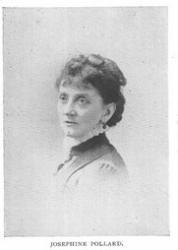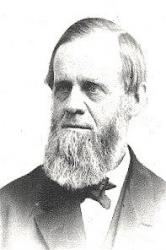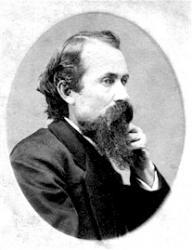Planning worship?
Check out our sister site, ZeteoSearch.org,
for 20+ additional resources related to your search.
- |
User Links
Person Results
‹ Return to hymnal




Export as CSV
Josephine Pollard

1834 - 1892 Person Name: Josepine Pollard Hymnal Number: 64 Author of "I must labor For my neighbor" in White Robes for the Sunday School Josephine Pollard USA 1834-1892. Born at NYC, NY, one of seven children and daughter of an architect, she attended an exclusive girls school, Spingler Institute, and was a lifelong member of the Presbyterian Church. She was a founding member of the professional women’s club, Sorosis. She never married. She became an author, poet, and hymnist, writing many children’s books and for children’s magazines, including Harper’s, Scribner’s, and the New York Ledger. She wrote 44 books, mostly religious, for children, but also about history, birds, sports and games, and adventure stories. She also wrote 100+ hymn lyrics as well. She worked as an editor for the Sunday School Times and for the Methodist Book Concern, where she edited a magazine for African Americans. Her children’s books include: “History of the U.S.” (1884); “The life of George Washington” ; “The life of Christ for young people”; “History of the New Testament in words of one syllable” (1899); “History of the Old Testament in words of one syllable” (1899); “Bible stories for children” (1899). She was in poor health in her latter years. She died at NYC, NY.
John Perry
===============
Pollard, Josephine, born in New York, circa 1840, is the author of (1) "I stood outside the gate" (Lent), (2) "Joy-bells ringing, Children singing" (Joy) in I. D. Sankey's Sacred Songs and Solos, 1878.
--John Julian, Dictionary of Hymnology, Appendix, Part II (1907)
Josephine Pollard
Samuel Wolcott

1813 - 1886 Person Name: Rev. S. Wolcott, D.D. Hymnal Number: 8 Author of "Hear the voice of my contrition" in White Robes for the Sunday School Wolcott, Samuel, D.D., was born at South Windsor, Connecticut, July 2, 1813, and educated at Yale College, 1833, and Andover Theological Seminary, 1837. From 1840 to 1842 he was a missionary in Syria. On his return to America he was successively pastor of several Congregational congregations, including Belchestown, Massachusetts; Providence, Rhode Island; Chicago, &c. He was also for some time Secretary of the Ohio Home Missionary Society. He died at Longmeadow, Massachusetts, Feb. 24, 1886. His hymnwriting began late in life, but has extended to more than 200 hymns, many of which are still in manuscript. Those of his hymns which have come into common use include:—
1. All thy realms in midnight shrouded. Mission. In the Oberlin Manual of Praise, 1880.
2. Christ for the world we sing. Missions. Written Feb. 7, 1869. Its origin is thus recorded by the author: "The Young Men's Christian Associations of Ohio met in one of our Churches, with their motto, in evergreen letters over the pulpit, ‘Christ for the World, and the World for Christ.' This suggested the hymn 'Christ for the world we sing.'" It was when on his way home from that service that he composed the hymn. It is in several American collections, including Laudes Domini, 1884, &c.
3. Father, I own Thy voice. Trust and Aspiration. This, his first hymn, was written in 1868, more as an experiment in hymn-writing than anything else. It was published in the Rev. Darius E. Jones's Songs for the New Life. Chicago, 1869. It has since passed into other collections.
4. Goodly were thy tents, 0 Israel. Missions. Written May 31, 1881, and included in Laudes Domini, 1884.
5. Lo! the faith which crossed the ocean. Missions. In the Oberlin Manual of Praise, 1880.
6. O gracious Redeemer! O Jesus our Lord. The Love of Jesus. Written in 1881.
7. On the works of His creation, God the Creator.
In the Ohio Evangelical Association's Hymn Book, 1881.
8. Pitying Saviour, look with blessing. Prayer for the Penitent. In the Ohio Evangelical Association's Hymn Book, 1881.
9. Tell me Whom my soul doth love. Opening of Divine Service. A paraphrase of Cant. i. 8. Written Feb. 6, 1870. Included in Laudes Domini, N. Y., 1884.
10. To us have distant ages. Saints Days. In Dale's English Hymn Book, 1874.
11. This house, most holy Lord, is Thine. Opening of a Place of Worship. In Dale's English Hymn Book, 1874.
For most of the information given above we are indebted to Duffield's English Hymns, N. Y., 1886.
-- John Julian, Dictionary of Hymnology (1907)
================
See also in:
Hymn Writers of the Church
Samuel Wolcott
A. Cleveland Coxe

1818 - 1896 Person Name: Rev. A. C. Coxe, D.D. Hymnal Number: 58 Author of "Rise and Let Me In" in White Robes for the Sunday School Coxe, Arthur Cleveland, D.D. LL.D. One of the most distinguished of American prelates, and son of an eminent Presbyterian minister, the Rev. Samuel H. Cox, D.D., was born at Mendham, New Jersey, May 10,1818. Graduating at the University of New York in 1838, and taking Holy Orders in 1841, he became Rector of St. John's, Hartford, Connecticut, in the following year. In 1851 he visited England, and on his return was elected Rector of Grace Church, Baltimore, 1854, and Calvary, New York, 1863. His consecration as Bishop of the Western Diocese of New York took place in 1865. His residence is at Buffalo. Bishop Coxe is the author of numerous works. His poetical works were mostly written in early life, and include Advent, 1837; Athanasion, &c, 1842; Christian Ballads, 1840 (Preface to the English edition, April, 1848); Hallowe'en and Other Poems, 1844; Saul, a Mystery, 1845, &c. Some of Bishop Coxe's hymns are found in the collections of every religious body in America, except the official collections of his own. This is accounted for by his too scrupulous modesty. As a member of the Hymnal Committee, in 1869-71, he refused to permit the insertion of his own lyrics. As he has not preserved memoranda, and has no precise recollection of dates, several dates here given are somewhat uncertain.
1. Behold an Israelite indeed. St. Bartholomew. First appeared in "Poems," published with his Christian Ballads, 1840, and found in an altered form in the People's H. and the Hymnary.
2. Body of Jesus, 0 sweet Food. Holy Communion. Written at St. James's College, Maryland (since broken up by the Civil War), Ascension Day, 1858. It was first printed for private use, and then published in the Cantate Domino, Boston, 1859, No. 53, and again in other American collections. It is also in Schaff’s Christ in Song, 1869, and in The Churchman's Altar Manual, 2nd ed., 1883.
3. Breath of the Lord, 0 Spirit blest.Whitsuntide. Bishop Coxe considers this more worthy of being called a hymn than anything else from his pen. It was written long before it appeared in the New York Independent, Whitsuntide, 1878. It is in the Schaff-Gilman Library of Religious Poetry, 1881, and Brooke's Churchman's Manual of Private and Family Devotion, 1883.
4. Christ is arisen. Easter. This is suggested by, and partly translated from, the famous Easter Chorus in Goethe's Faust, "Christ ist erstanden" (see Goethe), and appeared in Hallowe'en, 1844.
5. He who for Christ hath left behind. St. Matthew. From his Christian Ballads, &c, 1840.
6. In the silent midnight watches. Christ knocking. From his Athanasion, &c, 1842; an impressive moral poem rather than a hymn on Christ knocking at the door, extensively used in America, and sometimes in England. Original text, Schaff's Christ in Song, 1869.
7. Lord, when Thou didst come from heaven. A hymn for Epiphany, on behalf of Western Missions, appeared among the "Lays "appended to Hallowe'en, 1844, and again in later editions of the Christian Ballad. It is sometimes abbreviated, as in Lyra Sac. Amer., " Westward, Lord, the world alluring."
8. Now pray we for our country. National Hymn. A stanza from Chronicles, or meditations on events in the history of England, called up by visiting her abbeys and cathedrals, and appeared in Christian Ballads, 1840. Originally it began, "Now pray we for our mother," and, with the succeeding stanza, was a call upon Americans to pray for their mother country. It is adopted by Dr. Martineau in his Hys., 1873.
9. 0 walk with God, and thou shalt find. Holiness. Appeared in his Hallowe’en, &c, 1844, and is found in Lyra Sac. Amer.
10. 0 where are kings and empires now! Church of God. The 6th stanza of his ballad "Chelsea," which appeared in the Churchman, 1839, and again in his Christian Ballads, 1840.
11. Saviour, sprinkle many nations. Missions. “Begun on Good Friday, 1850, and completed 1851, in the grounds of Magdalen College, Oxford." 1st published. in Verses for 1851, in Commemoration of the third Jubilee of the Society for the Propagation of the Gospel, edited by the Rev. Ernest Hawkins, 1851. It was subsequently appended to the English edition of his Christian Ballads. It is regarded as Bishop Coxe's best piece, and to many minds it is the loveliest of missionary hymns. Its use in England is very extensive. It is not found in the American Episcopal hymnal for the reason given above.
12. Still as our day our strength shall be. Temptation. Appeared in his Hallowe'en, &c, 1844, and Lyra Sac. Amer.
13. Soldier, to the contest pressing. Christian Conflict. From his Hallowe'en, &c, 1844, and Lyra Sac. Amer. It was written in 1834.
14. There is a land like Eden fair. From Hallowe'en, &c, into a few collections.
15. We are living, we are dwelling. Christian Soldiers. An impressive moral poem rather than a hymn, but extensively used. It appeared in his Athanasion, &c, 1840, and Lyra &xc.
16. Who is this, with garments gory. Passiontide. From his “Lays" appended to Hallowe'en, 1844, and again in his Christian Ballads. It is found in the Child's Christian Year, 4th ed. N.D., the People's Hymns, and other collections. It is in 4 stanza of 8 1. The last stanza is sometimes given as a separate hymn:—"Hail, all hail, Thou Lord of Glory."
17. When o'er Judea's vales and hills. Written cir. 1840, and published in his Hallowe'en, &c, 1844, and again, with the author's final corrections, made in 1869, in Schaff's Christ in Song (1870 ed. p. 112). Also in the English edition of his Christian Ballads. From this "Hymn to the Redeemer," two shorter hymns have been com¬piled : (1) " How beauteous were the marks divine." This is in almost universal American and occasional English use. (2) "O who like Thee, so calm, so bright," in the Hymnary, 1872.
Bishop Coxe has also translated the Pange lingua gloriosi corporis (q. v.), and is the author of the beautiful Christmas Carol, "Carol, carol, Christians," given in his Christian Ballads, &c. [Rev. F. M. Bird]
-- John Julian, Dictionary of Hymnology (1907)
A. Cleveland Coxe
Aldine S. Kieffer

1840 - 1904 Hymnal Number: 44 Author of "It Won't Be Long" in White Robes for the Sunday School Full name Aldine Silliman Kiefer
Aldine S. Kieffer
E. A. Barnes
1842 - 1942 Hymnal Number: 84 Author of "Dear Saviour, dear Saviour" in White Robes for the Sunday School Edward Albert Barnes, born January 24 1842. He was a life long resident of Chicago and a prolifich hymn writer, and active in the American Temperance Movement.
Dianne Shapiro, from http://mms.newberry.org/html/BarnesE.html
E. A. Barnes
W. S. Marshall
Hymnal Number: 7 Author of "Sing, children, sing, To the Lord your King" in White Robes for the Sunday School He composed tunes for gospel lyric writers.
John Perry
W. S. Marshall
R. G. Staples
b. 1833 Hymnal Number: 43 Author of "'Tis only thro' Jesus I live" in White Robes for the Sunday School Robert Griffin Staples. He was born Robert Griffin on January 24, 1833 in Washington DC. Both of his parents died in a carriage accident when he was an infant; he was then adopted by his mother's sister, Mary Ann King, and her husband, Samuel Johnson Staples and he was given the name Robert Griffin Staples. He was a captain in the Union Army during the Civil War and after the war was promoted to Major. He then worked as chief clerk in the Portsmouth United States Navy Yard. Religion was an important part of his life, as well as music. He died June 20, 1891 in Portsmouth, VA.
Dianne Shapiro, from Jean Brickey (great-granddaughter)
R. G. Staples
A. J. Abbey
1825 - 1887 Person Name: A. J. A. Hymnal Number: 17 Composer of "[What a meeting that will be]" in White Robes for the Sunday School Alonzo Judson Abbey, USA 1825-1887 Professor Abbey was a music teacher, collector, writer-composer, tune book compiler and sacred music publisher. George F Root often edited his published works.
John Perry
A. J. Abbey
R. A. Glenn
Hymnal Number: 48 Author of "Take up Thy Cross" in White Robes for the Sunday School Late 19th Century
Glenn’s works include:
New Melodies of Praise, with Aldine Kieffer (Singers Glen, Virginia: Ruebush, Kieffer & Company, 1877)
The Song Victor for the Sunday School and Public School Use (Cincinnati, Ohio: F. W. Helmick, 1878)
Purest Pearls, with G. Holmes & A. D. Kennedy (Cleveland, Ohio: J. H. Leslie, 1881)
Joy and Praise for Sunday Schools, with Daniel Crist (Cincinnati, Ohio: H. L. Benham & Company, 1886)
--www.hymntime.com/tch/
R. A. Glenn
Mrs. R. N. Turner
1857 - 1957 Hymnal Number: 46 Author of "Messiah is king" in White Robes for the Sunday School Fronie Bell Turner, married to Rev. R. N. Turner, pastor in the Protestant Episcopal Church.
Mrs. R. N. Turner


 My Starred Hymns
My Starred Hymns


